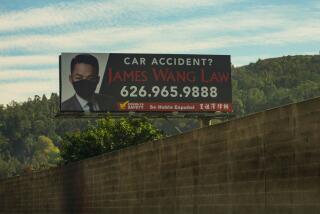Optical Pollution
- Share via
The billboards that bloom in garish profusion along federal highways these days are feeding on the fine print in a law whose sponsors meant it to stunt their growth.
The Highway Beautification Act of 1965 was supposed to hold down the number of billboards and keep them far enough away from the shoulders of federal highways to let some scenery peek through. It hasn’t worked. And the Senate should approve a bill that would wipe out the fine print as soon as possible after it gets back to Washington this week.
One cluster of fine print says that the federal government must reimburse billboard owners when it orders them to take down billboards that are in violation of the law. That was never really necessary. All that was needed was to serve notice that the billboards had to come down and wait five or six years until the investment had been amortized. The cash payment was the billboard industry’s idea.
Since the 1965 law was enacted the federal government has paid $200 million to get rid of billboards, working usually from a list submitted by the billboard industry itself. It is not surprising to discover that the list contained mostly old, mostly small billboards and that the $200 million was used to buy mostly bigger and all brand-new ones.
The results, recorded in a General Accounting Office study in 1983, all point to a direction directly opposite to the intent of the sponsors of the act. During 1983, 2,235 billboards in the zone of violation along federal highways were taken down and 13,522 new ones were built.
With budget deficits running nearly $200 billion a year, the federal government has better things to do with its money than pay for new billboards. That is where another cluster of fine print comes in. Local governments have no power to order billboards along federal highways taken down. That power was preempted by the federal government in the 1965 legislation. The best that local governments can do is beg Washington to find some money to pay for taking down billboards.
Other end runs are being made by the promoters of roadside optical pollution, the worst being the destruction of trees that blot out billboards. Some of the trees were planted in the first place with funds provided under the Highway Beautification Act.
What Congress should do is ban billboards altogether from federal rights of way. The way it fumbled the beautification act 20 years ago does not offer much hope that it could do better now. But a bill sponsored by Sen. Robert T. Stafford (R-Vt.), chairman of the Senate Environment and Public Works Committee, would at least eliminate the fine print. It would ban new billboards along federal roads, make it illegal to cut down trees just because they hide billboards, halt federal payments to billboard owners and let local governments set their own rules for billboards located along federal highways. It would not make the situation better, but it would at least prevent its getting worse and Congress should approve it.
More to Read
Sign up for Essential California
The most important California stories and recommendations in your inbox every morning.
You may occasionally receive promotional content from the Los Angeles Times.












